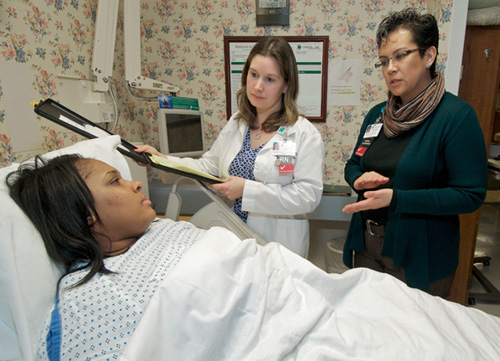Medical interpreters ensure language isn’t a barrier to high-quality health care


In any given month, patients treated at Christiana Care speak from 30 to 40 different languages.
That’s why Christiana Care provides qualified staff interpreters and Cyracom telephonic interpreting service.
According to Christiana Care Cultural Competency Manager Jacqueline Ortiz, monthly prescheduled requests for interpreters rose from 26 in March 2012 to 360 in December 2012.
Interpreters are dispatched regularly to the Emergency Department, the Helen F. Graham Cancer Center, maternity and many other areas of the hospitals when the need arises, Ortiz said.
“Demand is exploding — and that is a very good thing,” she said. “Interpreters are tremendously dedicated to making certain that patients understand their care so that they can make informed decisions.”
Christiana Care Language Services has 10 interpreters, including seven who speak Spanish and three who are fluent in American Sign Language. There are plans to hire more.
About 80 percent of the population with limited proficiency in English speaks Spanish, Ortiz said. Aside from Spanish, top requested languages include Arabic, Mandarin Chinese, Haitian Creole and Korean.
But Christiana Care patients speak dozens of other languages. Most of those patients communicate with interpreters through ubiquitous, blue telephones placed throughout the health system and through interpreters from local agencies when the encounter requires an in-person interpreter.
“By using a blue Cyracom phone or by dialing extension 6000 from any phone with a speakerphone at Christiana Care, you can access interpreters in 150 languages,” Ortiz said.
Sometimes, a language is so rarely encountered in the United States that even Cyracom is stumped.
For example, an elderly patient at Christiana Hospital could communicate only in a Creole dialect spoken by a few thousand people in the African nation of Sierra Leone. When Cyracom indicated they did not offer this language, Bonnie Osgood, RN, nurse manager of 4 Medical at Wilmington Hospital, contacted Language Services and they found another telephonic interpretation company that was able to provide an interpreter in that language.
“Bonnie, her staff and the patient were very pleased,” Ortiz said.
A recent pilot research project led by Deborah Ehrenthal, M.D., director of Health Services Research for Women and Children and medical director of OB-GYN Department Women’s Health Programs, discovered that among 391 mothers who delivered babies at Christiana Hospital during a six-week period, patients spoke 19 different languages — including seven different tongues spoken in India alone.
The study found that of the mothers who communicated in a language other than English, 76.7 percent had used a family member or friend as an interpreter at some time during their stay.
“When providers rely on patients’ family or friends, important information often gets lost in translation,” Ortiz said.
Having access to a qualified, in-house individual who speaks the patient’s language is an essential step in improving patient safety, education and quality of care, she said.
For example, she described a situation in which a daughter interpreted for her Vietnamese-speaking mother, who had been diagnosed with hepatitis C. Doctors asked if the mother had any history of risky sex or drug abuse. The daughter spoke to her mother and then responded “no.”
In truth, the daughter asked her mother another unrelated question and gave the doctor what she assumed was an accurate response. Why? Culturally she felt it would have been inappropriate for her to ask her mother about such personal information. She worried the question might make her mom feel uncomfortable. It wasn’t until the medical interpreter arrived that the care team was able to get accurate information about the patient’s medical history.
In 2011, the Joint Commission developed new standards for effective communication that require the use of qualified interpreters.
“With a qualified medical interpreter, both patients and providers benefit from clear communication,” Ortiz said.